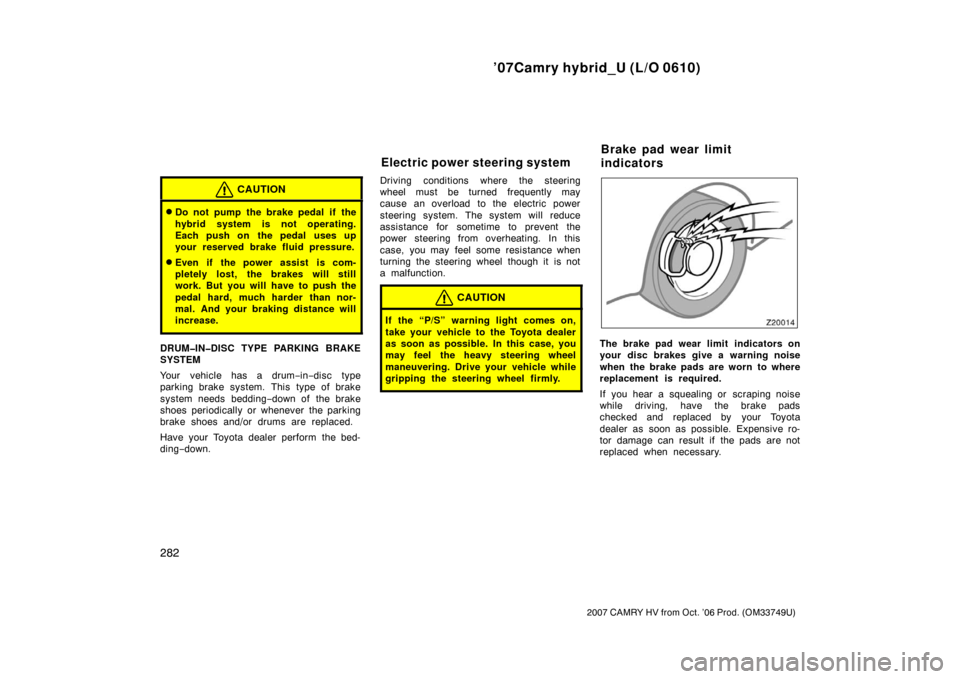Page 155 of 405
’07Camry hybrid_U (L/O 0610)
143
2007 CAMRY HV from Oct. ’06 Prod. (OM33749U)
MessageStatusAction
qSteering lock is stuck.Turn steering wheel slightly.
rOil change is nearly due.Check engine oil.
sOil change is due.Change engine oil.
tWasher fluid level is low.Add washer fluid.
uMoon roof is opened with “POWER” switch turned off.Close moon roof.
vFuel door is left open.Close the fuel door.
Page 294 of 405

’07Camry hybrid_U (L/O 0610)
282
2007 CAMRY HV from Oct. ’06 Prod. (OM33749U)
CAUTION
�Do not pump the brake pedal if the
hybrid system is not operating.
Each push on the pedal uses up
your reserved brake fluid pressure.
�Even if the power assist is com-
pletely lost, the brakes will still
work. But you will have to push the
pedal hard, much harder than nor-
mal. And your braking distance will
increase.
DRUM�IN�DISC TYPE PARKING BRAKE
SYSTEM
Your vehicle has a drum−in −disc type
parking brake system. This type of brake
system n eeds bedding −down of the brake
shoes periodically or whenever the parking
brake shoes and/or drums are replaced.
Have your Toyota dealer perform the bed-
ding− down. Driving conditions where the steering
wheel must be turned frequently may
cause an overload to the electric power
steering system. The system will reduce
assistance for sometime to prevent the
power steering from overheating. In this
case, you may feel some resistance when
turning the steering wheel though it is not
a malfunction.
CAUTION
If the “P/S” warning light comes on,
take your vehicle to the Toyota dealer
as soon as possible. In this case, you
may feel the heavy steering wheel
maneuvering. Drive your vehicle while
gripping the steering wheel firmly.
The brake pad wear limit indicators on
your disc brakes give a warning noise
when the brake pads are worn to where
replacement is required.
If you hear a squealing or scraping noise
while driving, have the brake pads
checked and replaced by your Toyota
dealer as soon as possible. Expensive ro-
tor damage can result if the pads are not
replaced when necessary.
Electric power steering system
Brake pad wear limit
indicators
Page 321 of 405

’07Camry hybrid_U (L/O 0610)
309
2007 CAMRY HV from Oct. ’06 Prod. (OM33749U)
Make sure your coolant is properly pro-
tected against freezing.
Only use “Toyota Super Long Life Coolant”
or similar high quality ethylene glycol
based non−silicate, non −amine, non− nitrite,
and non− borate coolant with long −life
hybrid organic acid technology. (Coolant
with long −life hybrid organic acid
technology is a combination of low
phosphates and organic acids.)
See “Checking the coolant level” on page
357 in Section 7 −2 for details of coolant
type selection.
For the U.S.A.—“Toyota Super Long Life
Coolant” is a mixture of 50% coolant and
50% deionized water. This coolant pro-
vides protection down to about −35 �C
( − 31 �F).
For Canada—“Toyota Super Long Life
Coolant” is a mixture of 55% coolant and
45% deionized water. This coolant pro-
vides protection down to about −42 �C
( − 44 �F).
NOTICE
Do not use plain water alone.
Check the condition of the 12 volt bat-
tery and cables.
Cold temperatures lower the performance
of the 12 volt battery, so it must be in top
shape to provide enough power for winter
starting. Section 7 −3 tells you how to
visually inspect the 12 volt battery. Your
Toyota dealer and most service stations
will be pleased to check the level of
charge.
Make sure the engine oil viscosity is
suitable for the cold weather.
See page 356 in Sec t i on 7 −2 for recom-
mended viscosity. Leaving a heavy sum-
mer oil in your vehicle during winter
months may cause harder starting. If you
are not sure about which oil to use, call
your Toyota dealer—they will be pleased
to help.
Keep the door locks from freezing.
Squirt lock de −icer or glycerine into the
locks to keep them from freezing. Use a washer fluid containing an anti-
freeze solution.
This product is available at your Toyota
dealer and most auto parts stores. Follow
the manufacturer ’s directions for how
much to mix with water.
NOTICE
Do not use engine antifreeze or any
other substitute because it may dam-
age your vehicle’s paint.
Do not use your parking brake when
there is a possibility it could freeze.
When parking, put the transmission into
“P” and block the rear wheels. Do not use
the parking brake, or snow or water accu-
mulated in and around the parking brake
mechanism may freeze, making it hard to
release.
Keep ice and snow from accumulating
under the fenders.
Ice and snow built up under your fenders
can make steering difficult. During bad
winter driving, stop and check under the
fenders occasionally.
Winter driving tips